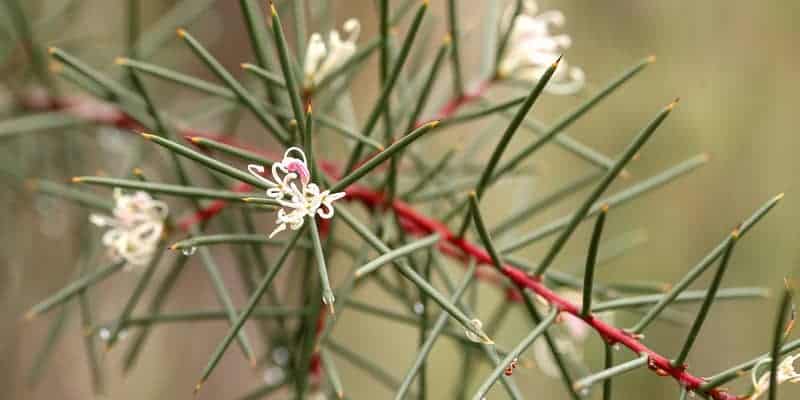We can’t blame you if you can’t get enough of native plants to add to your garden collection. These unique botanicals are obsession-worthy!
If the Hakea Laurina and Hakea Petiolaris are too wild for your taste, there’s a species that just might be your cup of tea: the Hakea Pink Lace.
A brief description of the Hakea Decurrens
As with other Hakea species, the Hakea Decurrens Pink Lace is a member of the Proteaceae family and a native Australian flowering plant. It is also called Hakea Decurrens Bushy Needlewood.
There are three known subspecies of this variety: H. Decurrens subsp. decurrens, H. Decurrens subsp. Platytaenia, and H. Decurrens subsp. physocarpa.
This plant can grow between 1.8-2.2m tall and 1.5-2m wide and is classified as a large shrub or small tree depending on its size.
You won’t lack colour when you have the Pink Lace gracing your outdoor space. The Pink Lace, as its name suggests, has pink flowers that appear in leaf axils from May through September.
The flowers are sometimes white or cream in colour, and tinged pink.
Each leaf of the Pink Lace is thin and needle-shaped. This variety’s beautiful evergreen foliage forms a graceful sweeping habit that gives the shrub a daintier appearance than its other Hakea cousins.
Shorter branches of the Pink Lace are densely hairy, but they become smooth over time.

Uses
The Pink Lace’s hardiness makes it ideal for gardening beginners and busy plant parents. You won’t have to worry about giving the Pink Lace Hakea extra care as this plant is easy to maintain.
Its drought resistant nature also gives you plenty of opportunity to grow it in coastal areas with minimal fuss.
The Pink Lace Hakea is as versatile as it is low-maintenance — it has great potential as a screen plant and is excellent as an ornamental.
One look at its beautiful inflorescence and foliage and you’ll know that this shrub will make a captivating addition to your garden or courtyard.
You can even grow the Pink Lace in a container to fit smaller spaces — it works just as well when placed on balconies or in pocket gardens.
Here’s the best part: because Hakeas have a pollen presenter in their flowers’ styles, they quickly attract pollinators such as bees, birds, and butterflies to your garden.
That’s a huge plus when you want to breathe life to your outdoor space!
Where to find Hakea Decurrens

This Australian plant thrives in dry forests, woodlands, and rocky sites. You can find plenty of Pink Lace shrubs in New South Wales, Tasmania, and Victoria.
The subspecies H. Decurrens subsp. Decurrens, in particular, inhabits the western slopes and plains of the Great Dividing Range of New South Wales.
How to care for Hakea Decurrens
Make no mistake, the Pink Lace is no damsel-in-distress! Far from being delicate, this variety can withstand harsh weather conditions.
It’s a favourite among garden owners for being drought- and frost-tolerant.
Light requirements
Plant your Pink Lace under full sun to semi-shade to ensure optimal growth.
Soil
Unlike the moisture-loving Hakea Nodosa, the Hakea Decurrens needs a well-drained planting mix.
Plant your shrub in mildly acidic or neutral sandy or clay loam for best results.
Water

With the Pink Lace, you won’t have to worry about setting aside time from your busy schedule for watering — the Hakea Decurrens needs minimal watering because of its drought resistant nature.
Pruning
Because it is a fast grower, your Pink Lace will benefit from pruning. Prune your Hakea while it is young to maintain its compact form.
A 10-15cm trim from the tip growth will keep your Hakea tidy and help manage its size.
Common Hakea Decurrens problems
Even with minimal maintenance, your Pink Lace shrub is bound to grow in leaps and bounds.
It can be quite perplexing therefore when you suddenly find your Hakea plant deteriorating. There are cases when this happens, with root infection or fertiliser poisoning being the common culprits.
For instances such as the one mentioned above, the best action to take is to call professional gardening services.
Gardening pros can look into the root cause of the problem and recommend best care practices for your Hakea variety.
Better yet, they can do regular gardening maintenance for you to ensure your plants’ health all year round.

